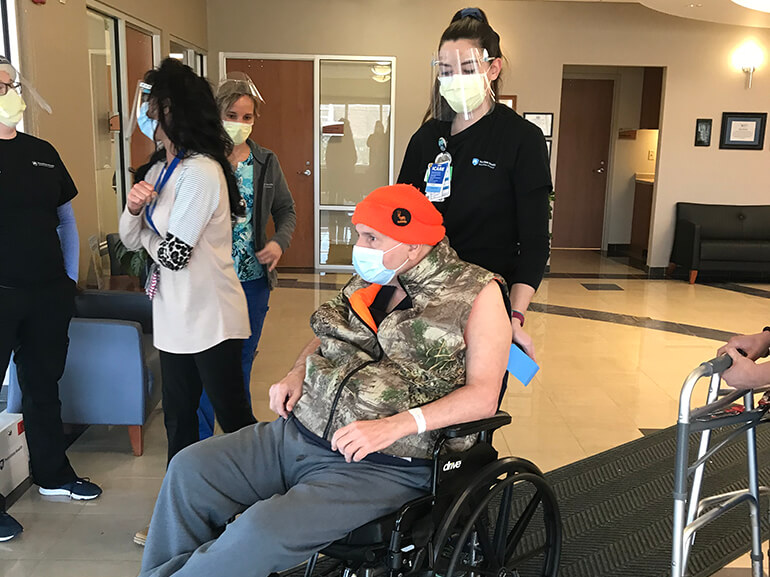Lloyd's story

Lloyd (Mike) Henry, 58, is a true outdoorsman. He enjoys hunting and taking care of the many acres of land around his home. He also spends as much time as he can with his wife, Jill, his kids and grandkids.
Sadly, his world turned upside down one day in March when a tree branch fell on his head at work causing a traumatic brain injury. To remove excess fluid from his brain, doctors removed a bone flap and inserted a shunt. Mike also needed a breathing and feeding tube placed. This was the beginning of a long recovery journey for Mike.
Once he stabilized two months later, Mike transferred to Penn State Health Rehabilitation Hospital. Upon arrival, he was minimally conscious, only able to follow simple, one-step commands. He also suffered from severe upper and lower body weakness.
His rehabilitation team assessed Mike’s condition and put a plan in place to help Mike return to his family.
During therapy sessions, Mike made steady progress showing improvement with his sitting balance, command following, speaking using a speaking valve and eating small amounts of food. He became strong enough to transfer to a skilled nursing facility where he continued to recover.
A year later, Mike felt he’d have more to gain by returning to Penn State Health Rehabilitation Hospital for additional therapy. His goal was to return home to his wife once modifications were made to their house including a ramp entrance and a bedroom and bathroom on the first floor.
During Mike's second round of rehabilitation, this occupational therapy team primarily focused on his ability to participate in activities of daily living (ADLs) including dressing and showering, as well as his ability to safely transfer from surface to surface. Previously, Mike had relied upon caregivers at the prior facility to bathe him, including sponge baths rather than bathing while seated in a shower. With the use adaptive equipment and some creative strategies, Mike progressed to being able to bathe himself with minimal assistance. This was a big win for Mike.
Occupational therapy also worked on transfer training, including Mike's ability to safely stand and pivot between his bed, wheelchair, toilet and shower chair in order to complete personal tasks with greater independence. Over time, Mike was able to pull himself up to a standing position using a grab bar with minimal assistance. Jill also received training so she could assist Mike when he returned home.
Physical therapy also focused on transfers including standing, pivoting and getting in/out of a car as well as propelling his wheelchair using his arms and legs. Soon, Mike was training in the parallel bars, progressing from standing, to marching in place, and eventually to walking short distances using a rolling walker with moderate assistance.
Meanwhile, his speech therapists addressed ongoing swallowing and cognitive impairments. Due to swallowing difficulties, Mike was able to eat regular food items but required liquids to be thickened in order to swallow safely. To improve his swallowing function, he completed various exercises and engaged in a virtual reality device, called Synchrony, to visualize swallowing. Due to his injury, Mike had difficulties with cognition including focusing, memory and problem solving skills. Knowing that Mike was a longtime sportsman, therapists integrated hunting magazines and outdoors-related TV programming into search tasks for Mike to work on these deficits.
Mike's turning point was being able to complete stand-pivot transfers from his bed to his wheelchair with minimal assistance. That was integral to him returning home. He also enjoyed being able to propel his wheelchair with supervision, allowing him more independence.
Mike was very motivated to get home to his wife and family after almost two years of recovering in various care settings. Within one month of his second stay at Penn State Rehabilitation Hospital, he was able to make it happen.